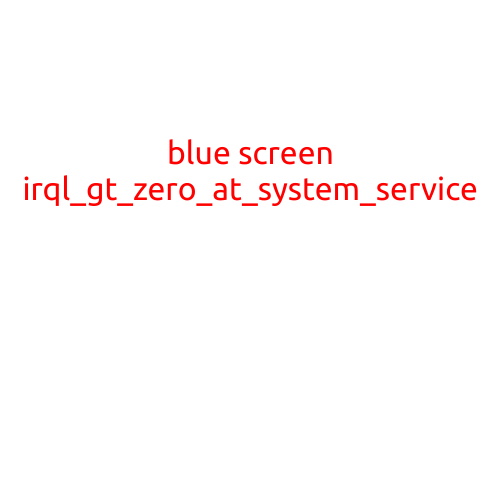
Title: “The INFURIATING ‘4090 Blue Screen’: What It Means and How to Fix It”
Are you tired of dealing with frustrating PC errors and blue screens? If so, you’re not alone. One of the most common and dreaded errors is the ‘4090 Blue Screen,’ which can strike at any moment and leave your computer inoperable.
In this article, we’ll delve into the world of blue screens, explore what the ‘4090 Blue Screen’ means, and provide actionable steps to help you troubleshoot and fix this pesky error. By the end of this article, you’ll be well-equipped to tackle even the most stubborn blue screens and get your computer back up and running smoothly.
What is the ‘4090 Blue Screen’?
The ‘4090 Blue Screen,’ also known as the “STOP 0x4090” or “IRQL_NOT_LESS_OR_EQUAL” error, is a type of blue screen of death (BSOD) that appears on Windows-based computers. It occurs when a critical driver or system component fails to function correctly, causing your computer to crash and display a blue screen with error information.
The ‘4090 Blue Screen’ is often accompanied by an error message, such as:
- “IRQL_NOT_LESS_OR_EQUAL”
- “A critical system driver is missing or corrupted”
- “A hardware error has occurred”
Causes of the ‘4090 Blue Screen’
The ‘4090 Blue Screen’ can be caused by a variety of factors, including:
- Driver issues: Outdated, corrupted, or incompatible drivers can cause system crashes and blue screens.
- Hardware problems: Faulty or malfunctioning hardware components, such as RAM, graphics cards, or hard drives, can trigger the ‘4090 Blue Screen.’
- Corrupted system files: Changes to system files or registry entries can cause errors and blue screens.
- Virus infections: Malware or viruses can compromise system files and cause the ‘4090 Blue Screen’ to appear.
- Overheating: High temperatures can cause hardware components to malfunction, leading to blue screens.
How to Fix the ‘4090 Blue Screen’
Fortunately, fixing the ‘4090 Blue Screen’ is often a straightforward process. Here are some steps to help you troubleshoot and resolve this error:
- Restart your computer: Sometimes, a simple reboot can resolve the issue. Try restarting your computer and see if the ‘4090 Blue Screen’ recurs.
- Run a virus scan: Malware can cause blue screens, so run a full virus scan using your antivirus software to detect and remove any malicious files.
- Update drivers: Outdated drivers can cause system conflicts, so update your drivers using the Device Manager or the manufacturer’s website.
- Check for corrupted system files: Use the System File Checker (SFC) tool to scan and repair corrupted system files.
- Run a memory test: Faulty RAM can cause blue screens. Run a memory test using a tool like MemTest86+ to detect and diagnose issues.
- Update Windows: Make sure your Windows installation is up-to-date, as newer installs may include bug fixes or patches that resolve the ‘4090 Blue Screen’ issue.
- Try a System Restore: If you’ve made recent changes to your system, try restoring your computer to a previous point when it was functioning correctly.
- Contact a professional: If none of the above steps resolve the issue, it may be time to seek professional help from a computer technician or the manufacturer’s support team.
Conclusion
The ‘4090 Blue Screen’ can be frustrating and disruptive, but by understanding its causes and taking proactive steps to troubleshoot and fix it, you can minimize downtime and get your computer back up and running smoothly. Remember to stay patient, be methodical, and don’t hesitate to seek help if needed. With the right tools and expertise, you can overcome even the most stubborn blue screens and enjoy a smooth, error-free computing experience.





